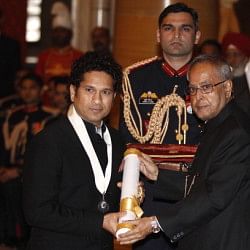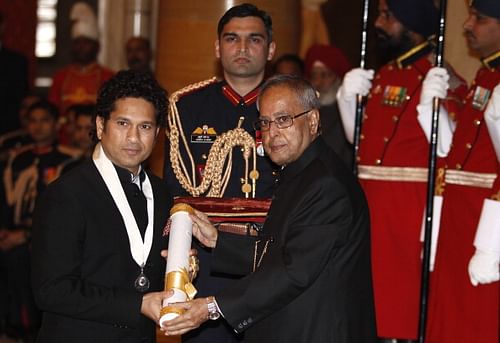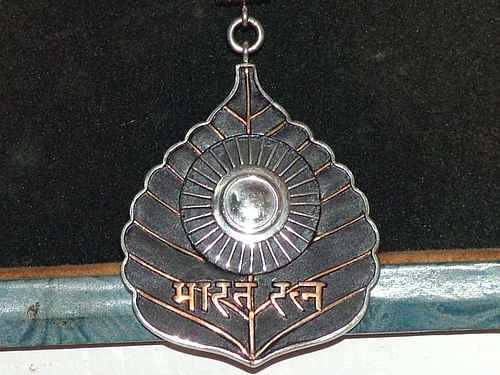
Did Sachin Tendulkar deserve the Bharat Ratna award before Dhyan Chand and Viswanathan Anand?
To the left, Sachin Ramesh Tendulkar dressed up in a nice suit, hair all well done, sporting a genial smile as always, empty arms drawn forward to receive. To the right, Pranab Mukherjee, the 13th President of the Republic of India, in his regular Nehru suit, hands stocked with a scroll of honour, was all set to give.
The next few moments, as the scroll changed hands from President to cricketer, from authority to civilian, marked a significant moment in the history of civilian honours in India.

Indian cricketer Sachin Tendulkar (L) receives the Bharat Ratna award from Indian President Pranab Mukherjee during an awards ceremony at the Presidential Palace on February 4, 2014 in New Delhi, India.
For the first time in the country’s history, a sportsperson had been awarded the country’s highest civilian honour. For decades to come, when people look back at the person who was the first to break the trend, the name of Sachin Tendulkar will reverberate loudly. Just about the perfect picture, right, for a man believed to be the greatest batsman and greatest cricketer of his generation, with some sections even stretching the narrative beyond the generational boundary to all of time?
Turns out it’s not as perfect a picture as it seems.
Tendulkar, of course, is no stranger to awards. The man is an exceptional talent and has been bagging awards by the truckloads ever since he started playing cricket. He would probably require an entire house just to stock the various awards he has received through his long career, maybe even two. There is no disputing his credentials as one of the finest cricketers of his generation.
But just as the ‘Bharat Ratna for Sachin’ campaign ushered in by millions of his fans and flippant media houses gained momentum, at the other end of the spectrum, sections of sportsmen and other regular citizens decided to crank up the volume on why they felt that hockey wizard Dhyan Chand deserved the Bharat Ratna ahead of Tendulkar. It sounds like a very valid point, but before we go into the intricacies of comparing the achievements of these two gifted mortals, it is important to understand the lead actor at the centre of it all.
The Bharat Ratna – what does the award represent?
The ‘Jewel of India’ is the Republic of India’s highest civilian award. For the record, the second highest is the Padma Vibhushan, the third highest the Padma Bhushan and the fourth highest, the Padma Shri. C.N.R. Rao and Sachin Tendulkar became the 42nd and 43rd persons respectively to receive the honour of the Bharat Ratna, following in the footsteps of 42 other individuals that includes foreign nationals such as Nelson Mandela and Mother Teresa (the award is not restricted to Indian nationals alone).

The Bharat Ratna medallion
The other significant thing about the Bharat Ratna is that a maximum of three awards can be made in a single year. And, as has probably been well known by now, the award wasn’t open to sportspersons until 2011; the stipulation before 2011 specified that the award was to be conferred “for the highest degrees of national service. This service includes artistic, literary, and scientific achievements, as well as “recognition of public service of the highest order.”
An amendment to this stipulation was made in December 2011 in order to enable sportspersons to be eligible for the award with the rule now allowing the award to be conferred “for performance of highest order in any field of human endeavour.”
Amongst other things that the award decrees on its holder is the seventh highest rank in the Indian order of precedence as far as ceremonial protocol is considered (no legal standing), behind only the President, Vice-President, Prime Minister, Governors of States, former Presidents, the Deputy Prime Minister, the Chief Justice of India, and the Speaker of the Lok Sabha.
Now that is some rarefied airspace indeed.
Perhaps the most important aspect of all that needs to be remembered is that the award is based on the recommendation of the Prime Minister’s Office.
How did sport enter the Bharat Ratna discussion?
As mentioned earlier, the amendment to expand the scope of the award to any and every field came about in 2011. The move, while welcome, and a strong source of encouragement to sportspersons in the country, does leave some questions as to why it took the 11th year of the 21st century for a country’s decision makers to bring about this change, for there has been no shortage of Indian sportspersons with stupendous achievements in all these years.
It could be argued that the move was made keeping Tendulkar in mind, and his possible coronation in the immediate aftermath of his impending retirement. But leaving aside sportspersons from other fields, there have been several other cricketers who have been more than deserving of the Bharat Ratna. There is Kapil Dev, who was special in his own right; perhaps the greatest all-rounder that India has produced till date and the captain that delivered the country’s first ever World Cup. His career definitely does classify as a ‘performance of the highest endeavour’. Or for that matter, even the careers of Sunil Gavaskar and Rahul Dravid (considering he retired earlier) do.
And when it comes to other sports – there’s Viswanathan Anand and Dhyan Chand.
It is now the right time we got introduced to the convulsive coming together of popular opinion, pandering and politics.
The Tendulkar decision
As the response drawn by the Right To Information (RTI) query filed by sports enthusiast Hemant Dube showed, haste underlined the decision of the Prime Minister’s Office (PMO) in setting up the recommendation for Tendulkar to receive the award.
The process was set in motion on November 14, 2013, coinciding in perfect fashion with the beginning of the ‘Master Blaster’s’ final Test in his hometown of Mumbai. As India went about putting the finishing touches to another home Test win, the process of him receiving the Bharat Ratna was being cemented with much alacrity.
The move smacked of slandering to an emotional groundswell of public emotion. It seemed like a desperate attempt for salvation by a ruling government in the doldrums going into election year and rocked by accusations of failed governance, in the hope that it would alleviate some of the beating that its image had taken in the public eye.
It is very easy to be swayed in today’s times by an event such as the retirement of Tendulkar, what with the extensive media coverage and social media outlets bombarding public thought and feeding off shared dogma while hardly leaving room for individual opinions and self thought.